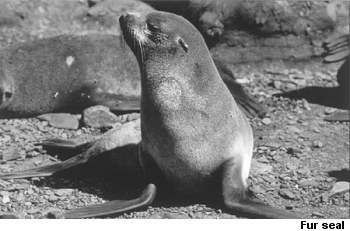
| Glasgow Digital Library | Voyage of the Scotia | BRUCE | PEOPLE | SHIP | ANTARCTIC | INDEX |
|---|
'Bruce and Burn-Murdoch were required to help with the slaughter and flensing of seals.'
William Speirs Bruce took part in the 1892 Dundee whaling expedition to the Antarctic, looking for right whales. The expedition was instructed to keep to the area east of the Antarctic Peninsula by their owners but no whales were found - so, to make the expedition a financial success, seals were killed for their skins and the oil in their blubber.
On the Scotia expedition in 1902-04 Bruce made detailed examinations of the seals found in the South Orkney Islands. Skeletons were taken home and his Scottish Oceanograhic Laboratory had several stuffed specimens. It was scientific investigation that interested Bruce, not commercial exploitation.

Seals and whales are unfortunate to be of economic value to people - the seals mainly for their skins and whales for their baleen and their oil.
The Inuit of the Arctic have always relied on seals for their meat, for fuel (oil from the blubber), the skins for clothing and the bones for needles, hooks and knives. The value of seals for fresh meat was realised by Bruce and Amundsen, both for human consumption and for the dogs. After outbreaks of scurvy on the Discovery expedition Shackleton and Scott realised that fresh meat was an important source of vitamin C.
The hunting of the seal began in the Arctic where a large cull is still made today. The discovery of seals in the Antarctic by early explorers resulted in a large number of boats going south - mainly from the USA and the UK. Many discoveries were made at this time but no records exist - sealers were very secretive about the areas where seals might be found.
The prime target for the hunters were the fur seals, found in huge numbers in the Antarctic, especially around the islands. The main market was Canton in China.
The discovery of South Georgia and the South Shetland Islands resulted in an influx of 'sealers'. By the time the sealer James Weddell went south there were few seals left and in 1829 there was not one fur seal left in the South Shetland Islands. The attention was then turned to elephant seals for their oil but by 1870 few elephant seals were left. The Dundee whaling expedition in 1892 was lucky to find enough seals to make the expedition meet its expenses.
Today, the seals south of 60°S are protected by the Antarctic treaty and their numbers are rising rapidly. On the island of Signy (60°43'S 45°36'W) in the South Orkney Islands the number has increased from less than 1,000 in the 1970s to over 20,000 today. This has caused environmental problems on this small island as the movement of the seals has destroyed large areas of mosses and lichens around the shore.
Antarctic seals
Species include: the most common crab-eater seal, the Weddell seal, the Ross seal, the elephant seal, and the vicious leopard seal
| Glasgow Digital Library | Voyage of the Scotia | BRUCE | PEOPLE | SHIP | ANTARCTIC | INDEX |
|---|